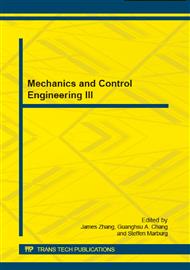p.320
p.325
p.329
p.336
p.341
p.345
p.350
p.357
p.362
System Identification of a Prototype of Hydraulic Platform Using ARX Model and Lagrange’s Equation
Abstract:
This paper presents the system identification of a prototype of hydraulic platform compare with two methods between the Autoregressive model structure with exogenous input and the Lagrange’s equation with SolidWorks’ simulation analysis tool. The system identification was identified, then the model was employed to simulate the multi-sine input response and the simulation results were compared to the experimental results. It was found that the model was developed using Lagrange’s equation more accurate than the Autoregressive model structure that having percentage best fit of 93.45% for the azimuth angle control and 92.25% for the elevation angle control. Overall, this method could be accepted with a good percentage best fit that compared with experiment results.
Info:
Periodical:
Pages:
341-344
Citation:
Online since:
December 2014
Authors:
Price:
Сopyright:
© 2015 Trans Tech Publications Ltd. All Rights Reserved
Share:
Citation:


